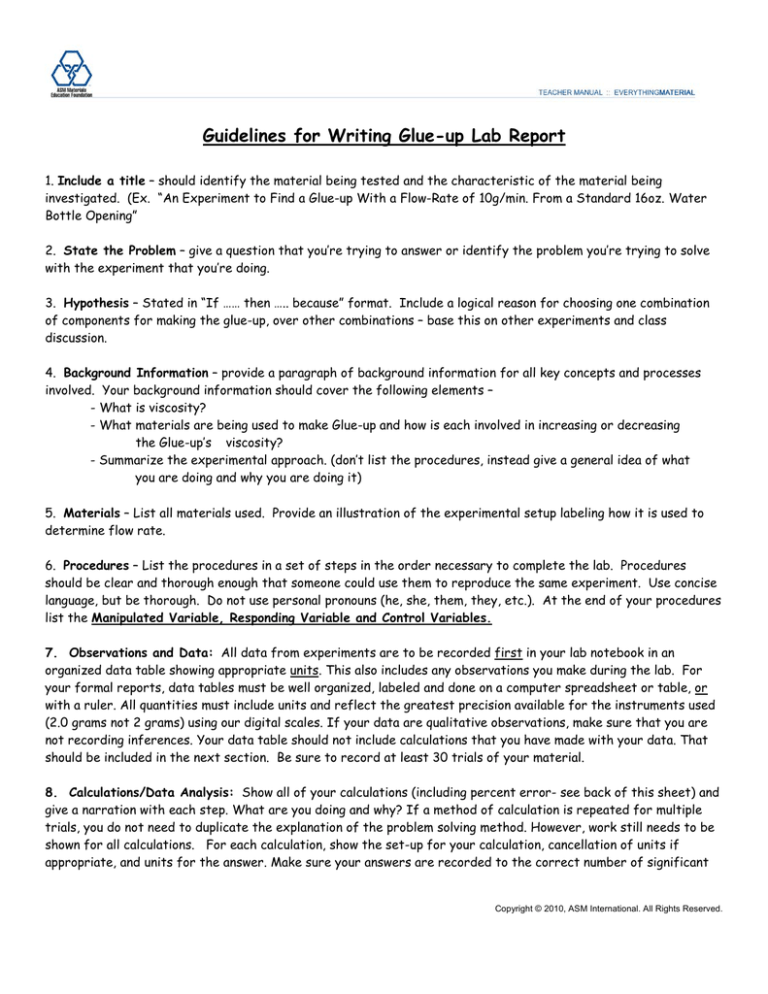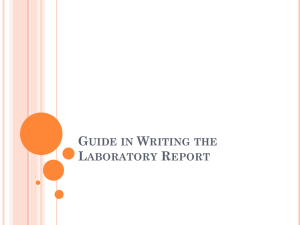
Guidelines for Writing Glue-up Lab Report
1. Include a title – should identify the material being tested and the characteristic of the material being
investigated. (Ex. “An Experiment to Find a Glue-up With a Flow-Rate of 10g/min. From a Standard 16oz. Water
Bottle Opening”
2. State the Problem – give a question that you’re trying to answer or identify the problem you’re trying to solve
with the experiment that you’re doing.
3. Hypothesis – Stated in “If …… then ….. because” format. Include a logical reason for choosing one combination
of components for making the glue-up, over other combinations – base this on other experiments and class
discussion.
4. Background Information – provide a paragraph of background information for all key concepts and processes
involved. Your background information should cover the following elements –
- What is viscosity?
- What materials are being used to make Glue-up and how is each involved in increasing or decreasing
the Glue-up’s viscosity?
- Summarize the experimental approach. (don’t list the procedures, instead give a general idea of what
you are doing and why you are doing it)
5. Materials – List all materials used. Provide an illustration of the experimental setup labeling how it is used to
determine flow rate.
6. Procedures – List the procedures in a set of steps in the order necessary to complete the lab. Procedures
should be clear and thorough enough that someone could use them to reproduce the same experiment. Use concise
language, but be thorough. Do not use personal pronouns (he, she, them, they, etc.). At the end of your procedures
list the Manipulated Variable, Responding Variable and Control Variables.
7. Observations and Data: All data from experiments are to be recorded first in your lab notebook in an
organized data table showing appropriate units. This also includes any observations you make during the lab. For
your formal reports, data tables must be well organized, labeled and done on a computer spreadsheet or table, or
with a ruler. All quantities must include units and reflect the greatest precision available for the instruments used
(2.0 grams not 2 grams) using our digital scales. If your data are qualitative observations, make sure that you are
not recording inferences. Your data table should not include calculations that you have made with your data. That
should be included in the next section. Be sure to record at least 30 trials of your material.
8. Calculations/Data Analysis: Show all of your calculations (including percent error- see back of this sheet) and
give a narration with each step. What are you doing and why? If a method of calculation is repeated for multiple
trials, you do not need to duplicate the explanation of the problem solving method. However, work still needs to be
shown for all calculations. For each calculation, show the set-up for your calculation, cancellation of units if
appropriate, and units for the answer. Make sure your answers are recorded to the correct number of significant
Copyright © 2010, ASM International. All Rights Reserved.
digits (figures), and are boxed or shown in a chart. You should calculate an average (show the work for this and
follow significant digit rules) for experiments involving multiple trials.
ERROR CALCULATIONS: When it is appropriate, you should accurately evaluate the validity of the results by
calculating either the percent error or the percent yield as described below. You should show the set-up and all the
work for the calculation. This calculation should be done once for the average calculated for experiments with
multiple trials.
% error = experimental value – expected (actual) value X 100
the expected (actual) value
Percent error is used when you know what the value should have been and you want to compare your value to it. A
negative value simply shows how many percent too low your value was.
9. Conclusion/Error Discussion: This is the section where you tie everything together. Use the following
examples. The conclusion should be written out in paragraph form and should include the following parts. Use the
italicized words as guides to begin your statements.
1. The purpose of this experiment was to ... (Check your purpose)
2. To achieve this goal we ... (Describe the experimental approach. Be very brief)
3. My experiment showed that ...(your results here- cite specific data)
(Use data and/or calculations from your experiment to justify your conclusions)
4. Factors that affected our results are ... (What is the error? What affect does this error have on your data?
See error analysis explanation below. Keep in mind you may have more that one error but NO "could of's" or
"should of's")
5. Our results could be improved if we ... (Suggestions for improvement on the lab, better equipment is not a valid
suggestion).
6. I could take this experiment further by… (What would you like to investigate more?).
Error Analysis:
Discuss what your group may have done and show how it specifically caused your results to be as they are. For
example: The density of iron should be 7.86 g/cm3. If during a density experiment, your group found the density of
iron to be 8.91 g/cm3 instead, discuss errors which would cause your density calculations to be too high. Make it
clear how each error would have driven the density to be a higher value. It is not appropriate to say “we must have
misread the graduated cylinder or measured wrong”. If you did this, your group should repeat the experiment!
Miscellaneous:
Type your report. Double space between sections, single space within a section.
Use the headings listed above for each section.
Edit / Proof-read your work.
Always turn in a neat, well organized report – on time.
Copyright © 2010, ASM International. All Rights Reserved.
Peer Edit for Glue-up Lab
Name of Editor: _________________________________
Format: Each section is clearly labeled with bold type and/or larger font headings. Name, period and date are
clearly indicated on the front page of the document.
1. Title: title indicates the material being worked on and the target flow rate
2. Statement of Problem: the problem statement is specific to the experiment with enough detail to identify
the goal of the experiment.
If no, what seems to be missing from the problem statement?
3. Background:
All key terms are correctly defined
A list of materials is given and a description of the effect that each has on the flow characteristics of the
material is provided with significant detail. Illustrations are provided that enhance the concepts of cross-linking
between the Borax molecules and Glue polymer molecules.
A summary of the experimental approach is provided so that the reader has a clear understanding of the goal of
the experiment.
4. Materials / Illustration: Materials are listed in one or more vertical lists
The list is specific: (ex. Amount of Borax Solution, Water and Glue are given)
The list is complete – if there are items listed in the procedures, but not in the materials – What are they?
Copyright © 2010, ASM International. All Rights Reserved.
Is an illustration included that adds to the understanding of the experimental design / set-up? Is this illustration
labeled so that it is clear what is being shown?
5. Variables: Did the student include manipulated, responding and controlled variables, clearly labeled?
Are there variables that you feel are missing or misidentified?
6. Procedure: the procedure is written in 3rd person (no use of “I”, “we”, “you”, etc.)
Put a check next to each item from the materials list as it appears in the procedure. Is there anything on the list
that is not specifically mentioned in the procedure? If yes – identify.
The procedure is extremely detailed and it is very clear exactly how to carry out each step.
Identify steps that are not detailed enough, or are confusing to you.
7. Observations and Data:
The student has included detailed observations for the experiment.
Each piece of data is clearly labeled as to what it represents.
The data is organized in a table showing appropriate units and precision (correct number of decimal places).
Only RAW data is included in the data table (no calculated or derived quantities).
8. Calculations / Data Analysis:
For each of the calculations, did the student give a narration (not just a label) explaining what they are doing and
why?
Use your calculator to compute all of their calculations. Identify any mistakes that you find.
For each calculation, did the student show the set-up for their calculation? (i.e. equation for percent error)
Units are included, not just in the answers, but in each number used in the calculation (when appropriate).
Cancellation of units is shown when appropriate.
The answer is shown using the correct number of significant digits (figures).
Identify any calculations that are missing.
9. Conclusions / Error Discussion
Copyright © 2010, ASM International. All Rights Reserved.
The student has reiterated the purpose of the experiment.
The student has described the experimental approach used to solve the problem (they have not given a step-bystep rehash of their procedure).
The student has shared their results using their calculations to justify their conclusions.
The student has identified potential sources of error.
Examples:
For each source of error identified, the student has described specifically how the error(s) would have influenced
the results. (Would it have increased or decreased the percent error, and WHY?) Very Important!
Is the connection between error and the affect on the results clear and well-explained?
The student has offered suggestions for improvement of experimental design.
Example(s):
The student has identified unanswered questions or suggestions for future research.
Copyright © 2010, ASM International. All Rights Reserved.



